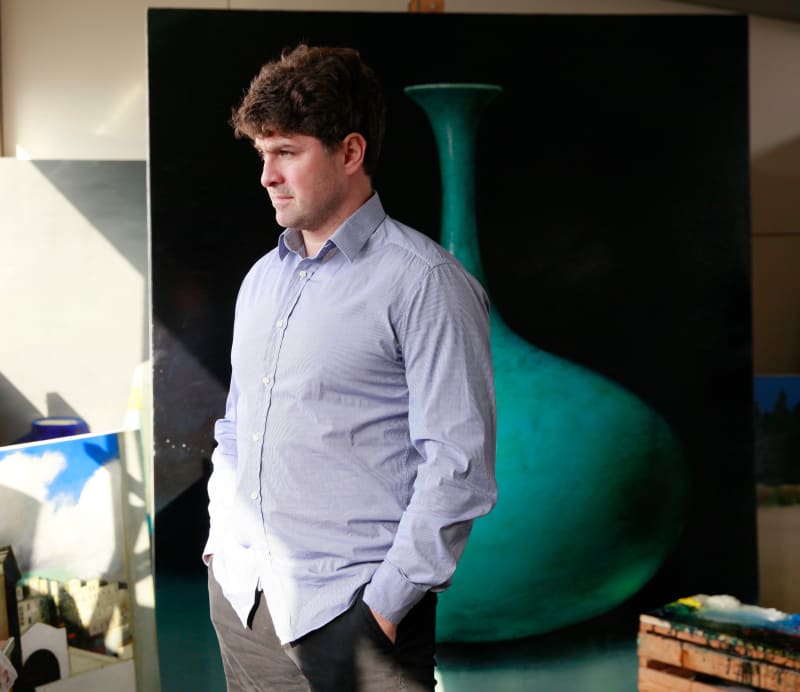Still life has always been the genre in which the virtuoso capability of painting, the deceptively real portrayal of objects and their surfaces, could be directly implemented. A carefully constructed arrangement of different things on a table with lighting from the side that makes the surfaces of the material and objects glow. Time seems to pause, thus making its relentless onward march all the more conscious.
Konstantin Totibadze (b. 1969) revives the rich tradition of the European still life painting in a surprising new way,establishing the link between past and present by implementing and developing values, vision, technique, and visual codes of XVI – XVIII centuries’ paintings and the genre of still life particularly. The artist works with oil on canvas, creating still lifes, one-object compositions and landscapes.
Totibadze’s objects, remarkable by their very realistic representation and the impression of being part of material life, form a system of codes and symbols which follows and develops tradition of still life painting. The food, vases and tableware painted by the artist are not only aesthetic objects, but also symbols of life, as was the case at the end of the 16th century when the still life genre had developed in Europe. Symbolical meanings are crucial for the depicted objects which he organizes with almost mathematical accuracy in one-line compositions. In most of Totibadze’s still lifes there is a basic installation: you see a few objects lined up on an elongated table and this table is covered by a tablecloth, simply white or with a sophisticated ornament which immediately catch the eye.
Another work series represent compositions with only one single empty vase, some of these mystical objects measure over two meters in size. Then the size of the vase corresponds approximately to that of the human body and, thus, the vase becomes a figure.
In his works, whether it be a still life or a one-object composition with one single vase, the artist takes up different stylistic devices of earlier art historical epochs which can stand side by side in the same picture without causing a striking break in style. Here we find, for example, a decanter which could have come from a picture by Willem Kalf, a piece of cheese with the drawing hardness of the early German still life painter Georg Flegel or an orange whose surface reminds one of the picturesque melting of Jean Siméon Chardin.
His works are not postmodern collages. There are no quotation marks which define the style or pictorial references on a meta-level. This would be postmodern according to Umberto Eco. Totibadze's updating of the seemingly outdated is a different one. It gives him a power in the immediate sense.
Totibadze's way of reviewing the art history of still life in a painterly and motivic way would have made him an ingenious forger. It takes a detective's eye to discover all the intricate details, such as single drops of water on the side of the vase.
However, the artist does not compete with the accuracy of the technical image. While, for example, Gerhard Richter transfers photographically captured light reflections into painting, Totibadze makes the light roll off the color, as Vermeer did. But when Richter depicts a single candle, there is a direct connection to Totibadze's vases, which sometimes resemble urns. Both motifs remind us, in the classical tradition of still life, of the transience of existence.
Born in 1969 in Tbilisi (Georgia), Konstantin Totibadze lives and works in Kronberg (Germany).
He studied in Moscow Academic Art School in 1985 -1988, at the Tbilisi Art University named after Y. Nikoladze” in 1988, at the Tbilisi Art Academy in 1989 -1991.
Konstantin Totibadze's works are in the collections of State Museum of Art of the Orient (Moscow, RU), Moscow Museum of Modern Art (RU) and in private collections in USA, Japan, Hong Kong, France, Germany, Italy, Austria, Switzerland, Russia, Great Britain, Portugal and the Netherlands.
In 2013 and 2014 his paintings were sold at Phillips auction house in London and New York, as well as at auctions at Bonhams auction house in London in 2021 and 2023. Furthermore, a successful online auction “KunstKontor” took place in Germany in 2022.
Solo exhibitions include among others:
“Landscapes”, Burg, Kronberg (DE), 2024; “Another Reality”, Bad Soden (DE), 2024; “The End of the Empire”, Kulturzentrum Enhlische Kirche, Bad Homburg (DE); "History of the Present", In-Gate Gallery, Brussels (BE), 2023- 2024; “Kunsthandel Hagemeier” Frankfurt/Main (DE), 2023; Stadtgalerie Badehaus, Bad Soden am Taunus, (DE), 2023, Art fair “Discovery Art Fair” Frankfurt (DE), 2021; “Totibadze Gallery” Moscow (RU), 2018, “Redline Gallery” GUM, Moscow (RU), 2019; “Totibadze Gallery” Moscow (RU), 2016; “Landscapes”, Moscow Museum of Modern Art (RU), 2012;“Atlas Group”, Moscow (RU); 2009: “Paradise Garden” VP Studio, Moscow (RU), 2007; “King Gallery”, Berkley, CA (USA), 2001;“Midsummer Night Dreams”, The State Museum of the Art of The Orient, Moscow (RU), 1996; “Gallery within a Gallery” ,The State Tretyakov Gallery, Moscow (RU), 1996.
Group exhibitions include among others:
Art Karlsruhe (with Kerstner Gallery) DE, 2025; |10 / Arthena Foundation, Dusseldorf (DE), 2024 - 2025; Gallery “Kunstkontor”, Wiesbaden (DE), 2022; Art Fair “Da Moscow” Moscow (RU), 2021; Art Fair “Da Moscow” Moscow (RU), 2019; Gallery “Proun” Moscow (RU), 2015; “Mosfilm Gallery”, Moscow (RU), 2010; Art Fair “Art Manezh”, Moscow (RU), 2006; “Gourmaniada, Art Play, Moscow (RU), 2005; “Art Party” at the Yakut Gallery, Moscow (RU), 2004.
